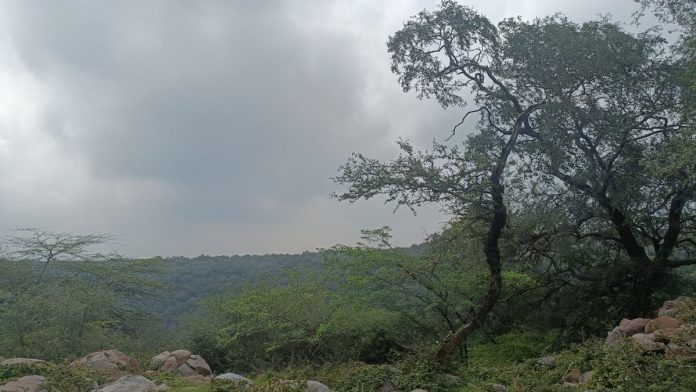New Delhi: The Delhi government on Monday published the official notification that finally demarcates the Southern Ridge as a ‘reserved forest’, thirty years after it first announced the ‘intent’ to notify the area in 1994.
The step secures long-overdue protection for the Delhi Ridge, the wide swathe of Aravalli forests in the national capital region. But why did it take three decades?
What is the Southern Ridge?
While the final notification under Section 20 of the Indian Forest Act, 1927 was passed on 24 October this year, it was published in the Delhi Gazette on Monday. It states that 4,080 hectares of forest land in the Southern Ridge is now demarcated as a reserved forest. This means that encroachment, tree felling, and other non-forest activities are now prohibited here.
“The Lt. Governor of the National Capital Territory of Delhi is pleased to hereby declare such lands as specified in the Schedule below, as Reserve Forest, with effect from the date of publication of the Notification in the Official Gazette,” read the document accessed by ThePrint.
The Delhi Ridge is divided into four sections — North Ridge, South-Central Ridge, Central Ridge and Southern Ridge. Together they cover about 7,000 hectares in the city. The Southern Ridge, spanning 6,200 hectares, is the largest by far, covering about 80 per cent of the total Ridge area. It also encompasses villages such as Asola, Ayanagar, Tughlaqabad, Maidangarhi, and Nebsarai.
Why the delay?
Despite the initial notification being issued in 1994, the Forest Department took more than 30 years to complete the demarcation because of land disputes and the long process of ground verification of Ridge land.
The Southern Ridge has been a point of contention for decades between the Delhi Development Authority (DDA), the Sports Authority of India, and several village authorities, all claiming a piece of the land.
Back in 2012, as part of the ground verification exercise, 21 villages were relocated out of the Ridge by the Forest Department, but the exercise was far from complete and is still unfinished in other parts of the Ridge.
While 4,080 hectares of the Southern Ridge are now officially a reserved forest, about 2,000 hectares are yet to be notified. The Central Ridge, South-Central Ridge and Northern Ridge also remain unprotected on paper and under threat of encroachment.
To declare any forest as a reserved forest, all land disputes and claims must be settled, and all encroachments must be removed by the designated forest authorities.
This exercise of ground verification, also called ‘ground truthing’, began after 1994, when the Section 4 notification was issued, but dragged on for decades. In the meantime, multiple cases were filed by environmentalists seeking legal protection for the Ridge in the Delhi High Court, the Supreme Court, and the National Green Tribunal.
“There is no count of how many times the verification process has started. Almost every year the process started, but because of some reasons, it was never completed,” Nisheeth Saxena, former Chief Conservator of Forests (CCF) of Delhi, had told ThePrint earlier. “Whenever the issue of notification came up, so did the issue of ground-truthing.”
What has helped drive forward the process has been a 2013 petition by activist Sonya Ghosh in the National Green Tribunal, which sought notification of the Delhi Ridge. The case witnessed multiple follow-ups and reprimands to the Forest Department by the NGT, asking for the final notification first in 2017, then in 2021, and again in 2024.
Also Read: How Chenab went from the river of love to the restless ticking time bomb
What has changed?
The new notification for the Southern Ridge finally lists the exact areas of each village, including the hectares, the specific khasras (unit of measuring agricultural land), and also the geo-coordinates. This ensures that in any case of encroachment, the Forest Department has the records to prove that the land belongs to the state and is protected under law.
Notifying the Ridge became imperative to protect it from multiple instances of encroachment, waste dumping, and tree felling by private entities, religious institutions and even government authorities at times.
The lack of notification also held up ecological restoration. Without identifying the Ridge and its official owners, steps such as landscape restoration, removal of invasive species, and increasing the green cover could not move forward.
Between 1994 and 2025, only 103 hectares of the 7,777 hectares of Ridge land had been officially notified as reserved forest under Section 20 of the Indian Forest Act, 1927.
Last year, in submissions to the NGT in the Sonya Ghosh case, the Forest Department said the Southern Ridge notification came under Phase I of its plan, and that the remaining sections will be cleared of encroachments, verified on the ground, and then notified in subsequent phases in a “time-bound manner”.
(Edited by Asavari Singh)






